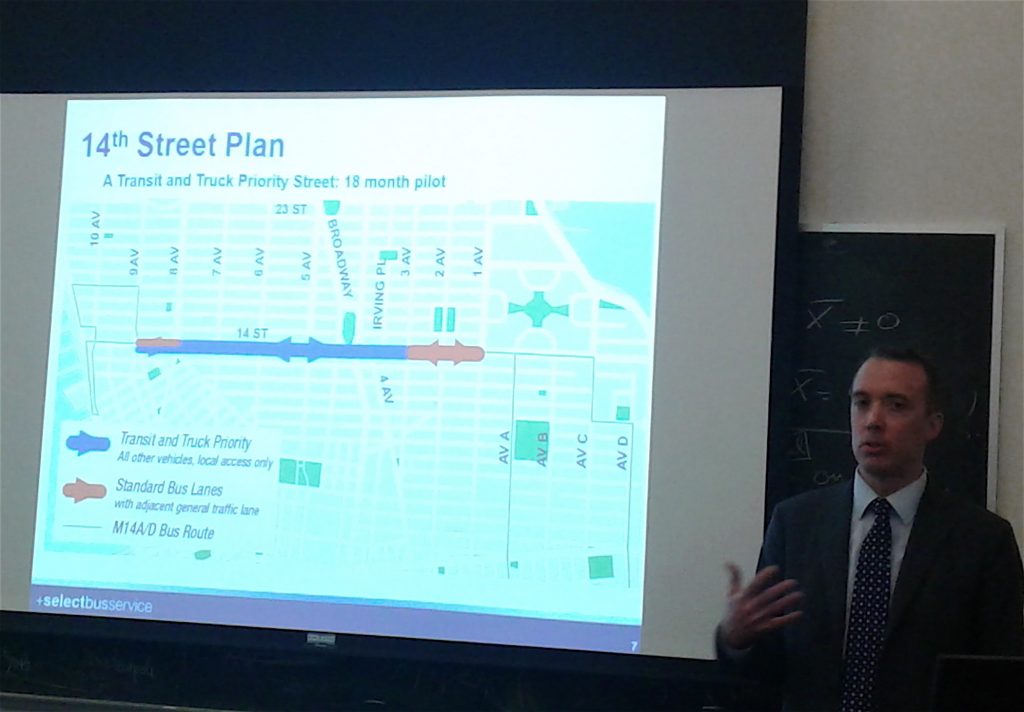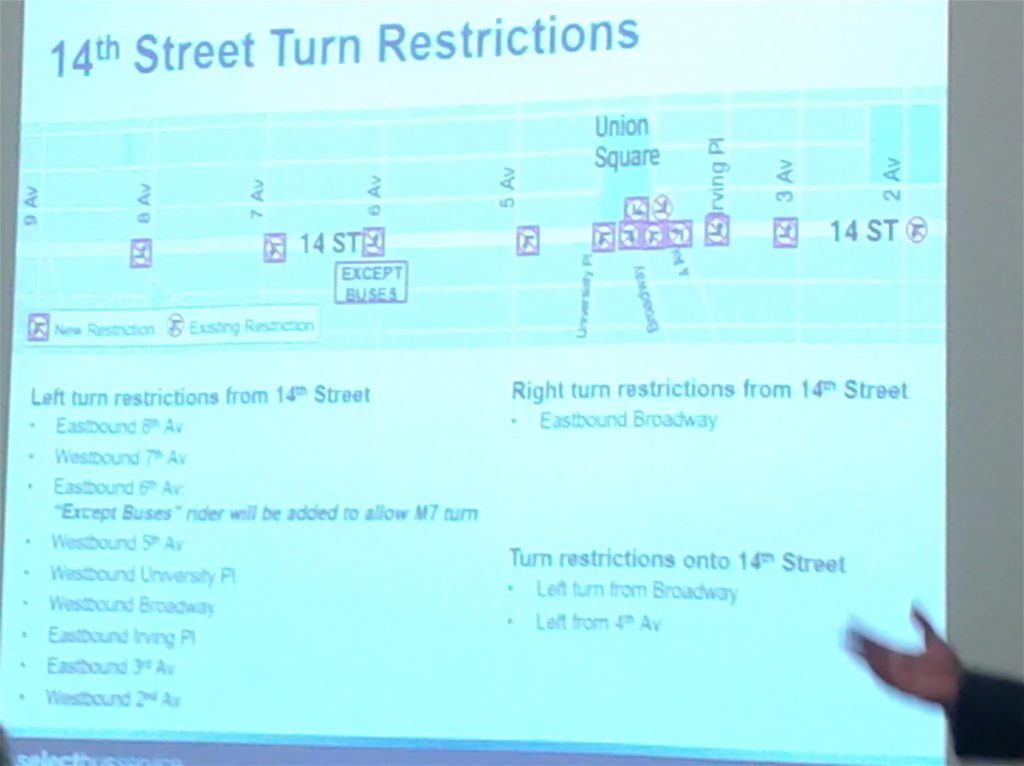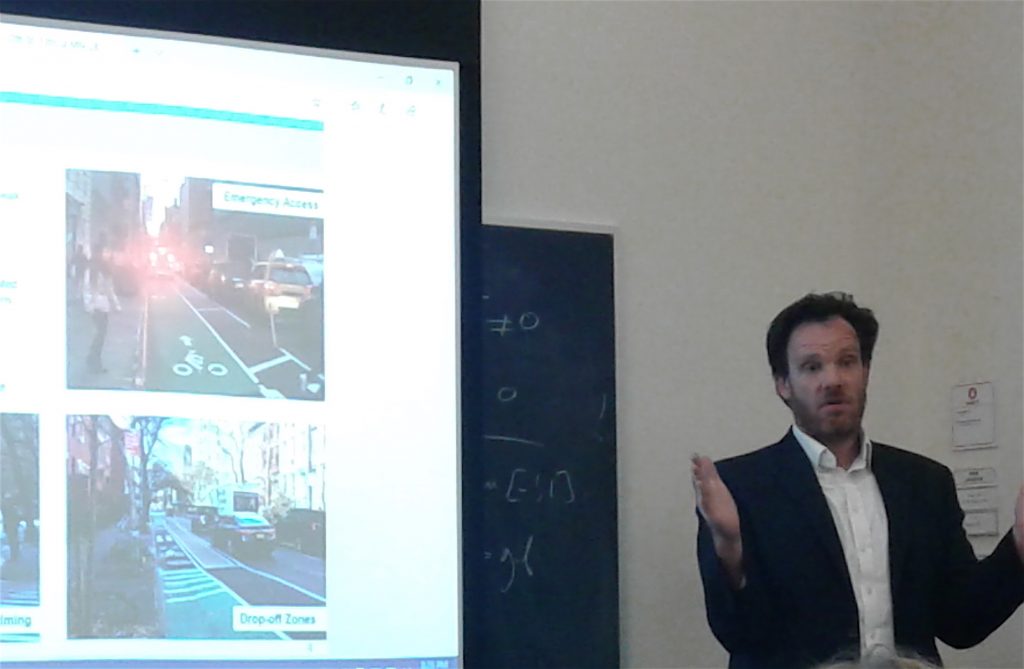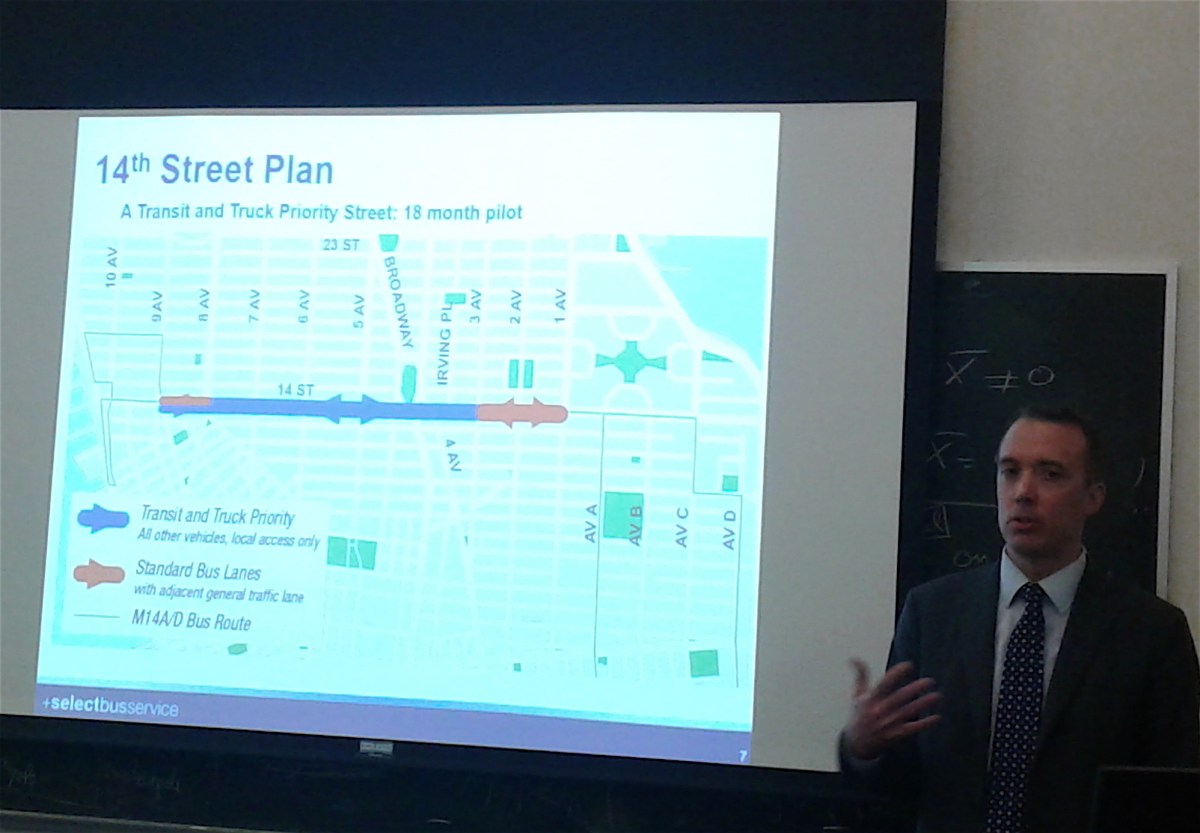BY LINCOLN ANDERSON | At a Community Board 2 committee meeting last Thursday night, city representatives lauded how a new Transit/Truck Priority lanes pilot plan would increase bus speed and reliability along 14th St.
But elderly residents from Westbeth, the famed affordable artists’ housing complex, and the far West Village, in general, angrily protested that part of the scheme — to drop the Abingdon Square loop at the M14A bus route’s western end — failed to consider their pressing transit needs.
The meeting was held by the C.B. 2 Traffic and Transportation Committee. Representatives from the New York City Transit Authority and the Department of Transportation outlined the pilot plan, which would start in June and last 18 months. Basically, the pilot would turn 14th St. from Third to Ninth Aves. into a through route for buses, trucks and emergency vehicles. Cars and cabs would be able to come onto the street for just one block — to make drop-offs or pickups — but would then have to take the next right turn.
As a D.O.T. presenter put it, a car could “drop off Grandma in the wheelchair to go to the doctor’s appointment.”
This would be the first Transit/Truck Priority street in the city. The program would be seven days a week, though its hours of operation have not been finalized.

Bus speeds would reportedly increase because there would be less traffic on the street and also because, with the M14A and M14D becoming exclusively Select Bus Service, the boarding process would be faster, as well. S.B.S. — with double-length buses that are “articulated,” meaning they can flex in the middle — is currently used on other major crosstown Manhattan streets, such as 23rd, 34th, 79th and 86th Sts. A presenter stressed that S.B.S. for 14th St. is not a pilot program, but would be permanent.
According to D.O.T., with the pilot plan, there would be a 30 percent decrease in travel time for bus riders along 14th St. The M14 is currently the city’s second-slowest bus, often moving as sluggishly as 4 miles per hour, the presenters said.
In addition, the plan would keep trucks from going on nearby side streets, they said, keeping them on 14th St., which is a designated truck route.
One of the agency reps noted that the M14 “has been hemorrhaging ridership” the past 10 years because of “slowness and unreliability.” Asked by this paper if that was partly due to the advent of all the for-hire vehicles, like Uber, clogging the streets, he and a fellow presenter — while not exactly answering the question directly — said that when these sort of bus improvements are made, use of for-hire vehicles and taxis has been found to drop.
One woman in the audience later scoffed that the Ubers would just shift to the side streets.
When changes proposed to the M14 route were broached at the meeting, complaints started erupting from the audience. Currently, on the Lower East Side legs of the M14, the bus stops every two blocks. Under S.B.S., this would change to every four blocks.
“That’s terrible!” someone shouted out.
When the intention to drop the Abingdon Square loop from the M14A route was noted, the agency representatives really heard it from the audience.
“We’re gonna sue you!” a woman called out. “ ‘Pain and suffering.’ You’ll pay!”
One of the agency reps tried to mollify the outraged seniors by saying Abingdon Square would continue to be served by the M11, M12 and M20 bus routes.
“But you can’t go crosstown!” someone yelled back.
But a Transit Authority presenter said riders could then transfer buses at 14th St. However, the seniors didn’t like the idea of extra bus transfers.
“It hurts when you have a mobility problem!” someone shot back.
Others noted that the buses on those other routes arrive infrequently, even less often than the M14A, making for long waits.
Ruby Ludwig, an ethnomusicologist from Westbeth, said if she were to take the M20 to 14th St. and then transfer to the M14, when she arrived at Union Square she would have to pay another fare to transfer to the subway.
“I mean, you have to get real,” she chided the agency reps. “People use walkers and have asthma.”
The Transit Authority presenter countered, “It has been increasingly difficult to operate buses in Abingdon Square because of the tight turns.” He added there have been complaints about Abingdon Square being used as a bus-layover area, as well.
Instead, the M14 would be rerouted to 10th Ave. and up into Chelsea a bit, improving service in that area, he said.
“We don’t care!” came a retort from the audience.

Ritu Chattree, a committee member, expressed the concerns of many in the room when she stated that the city was emphasizing speed over the needs of many local residents who rely on the buses as their primary mode of travel.
“The people that use the buses are usually people who can’t use other methods of transportation for physical or economic reasons,” she explained.
Shirley Secunda, chairperson of the C.B. 2 Traffic and Transportation Committee, asked the presenters point blank if the agencies had done any outreach to the far West Village community about the plan to cut the Abingdon Square loop. The Transit Authority rep said, “We heard a lot of complaints about buses laying over in that area.”
Another Transit Authority official chimed in that the meeting was, in fact, helping them get a bead on the community’s feelings about the plan.
“We’re getting that tonight,” she assured.
Secunda, not impressed, remarked, “Something must have fallen through the cracks.”
Secunda noted she had received a deluge of letters from people protesting the plan to lop off the Abingdon Square leg of the M14A. Westbeth, for one, mounted a letter-writing campaign on the issue.
“We received 168 letters,” Secunda said, incredulously, holding up a thick sheaf of papers. “I can’t remember when we got 168 letters before a meeting. Mostly seniors, a lot of disabled, physically challenged people — this is the bus they use to get crosstown. Most of them are saying, ‘We can’t walk eight blocks to get the bus.’”
Judy Pesin, a member of the 14th St. Coalition, which battled the city’s previous plan for a “busway” on 14th St., asked how someone would get a taxi on 14th St. other than by using a phone for ride-hail apps.
Veteran activist and Greenmarket founder Barry Benpe said some of the rejiggering that has already been done — such as relocating the M14 bus stop from Union Square — is a mistake.
“The Union Square stop should be restored,” he urged. “The [Green]market is there. It’s also an exchange with four subway lines. It’s not good planning, I don’t understand it at all. Speed is not the only concern of riders,” he stressed. “We want bus shelters at every stop. We want them heated.
“All your graphics are about vehicles,” he complained. “I want to see more about pedestrians and riders.”
Another speaker from the audience said it appears clear that the city, all along, had designs on making 14th St. a transportation “experiment.” The previous busway plan, along with the new bike lanes on 12th and 13th Sts., were pitched as critically needed to deal with the looming “L-pocalypse,” the full shutdown of the L train for 15 months. But the full L shutdown is now instead merely a “slowdown,” with repair work being done on weeknights and weekends, and service on the line never being fully stopped — yet the alleged transportation mitigation measures remain.
In short, the man said, the current 14th St. buses-and-trucks plan is “an agenda in search of a pretext. While the pretext has changed, the agenda hasn’t changed very much.”
He obliquely accused D.O.T. of being overly influenced by Transportation Alternatives, the pedestrian and cycling advocacy nonprofit.
“The agency hews to the agenda of a well-funded lobby,” he said.
A group of TransAlt members and volunteers was at the meeting, and two of their volunteers spoke out in favor of both the 14th St. plan and the new bike lanes.
Jacqueline Taylor Basker, an art historian and filmmaker from Westbeth, pointed out an obvious disconnect between most of the presenters and the seniors in the audience fuming over the bus changes.
“What is your average age, about 28?” she said of the young men. “It’s a problem. You don’t understand us. You don’t get it. For you, it’s easy to walk four blocks. For us, it isn’t.
“We have a lawyer considering a class-action suit if you do this,” she warned.
Rosemary Gaffney, a 14th St. resident, does not live in Westbeth, but came to speak in support of saving the Abingdon loop.
“I’ve been in the far West Village since 1965,” she told the meeting. “The artists moved into that area when no one else wanted to. You’re really not considering the population of these people who founded this part of the city. These are people who can’t afford Uber and use canes.”

Switching gears to the new protected bike lanes on 12th and 13th Sts., Ted Wright, D.O.T. director of bicycle and greenway programs, said these lanes have seen an increase in ridership, which will only rise further as the weather warms up.
Ed Picar, D.O.T. Manhattan borough commissioner, noted that Mayor Bill de Blasio recently said that D.O.T. would propose to make these new bike lanes permanent.
“There’s no L-train shutdown!” protested Elizabeth Winters, a 13th St. resident. “Get rid of the bike lanes!”
There was also presentation for a plan for a “shared street” on University Place between 14th and 13th Sts. Signage will tell drivers to slow down to 5 miles per hour here, and pedestrians will be able to share the roadway. The traffic direction on this block was reversed from north to south at the end of last year.
At the end of the marathon committee meeting, which ran around four hours, the committee members discussed resolutions they would write on these issues. Secunda said it was key to call for saving the Abingdon Square loop.
“Obviously, press like crazy to keep that service,” she said.
Dan Miller, another committee member, suggested adding an option for a single-length S.B.S. bus that could better navigate the tight turns at Abingdon Square.


















